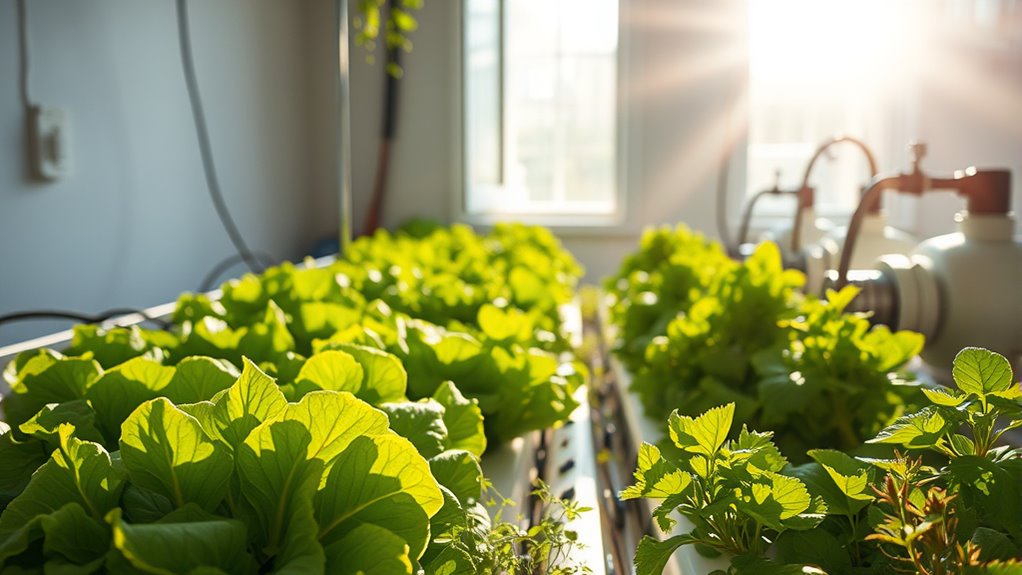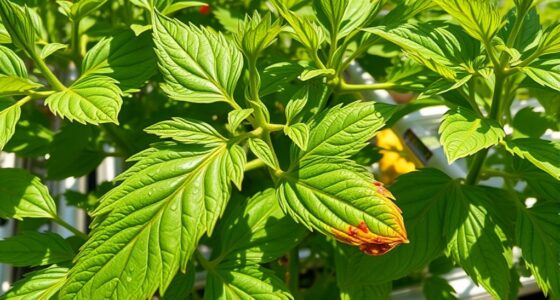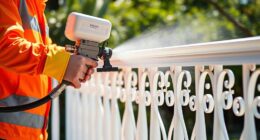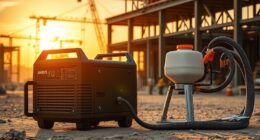During summer power outages, you need backup solutions to protect your hydroponic system from heat and circulation loss. Use solar panels with battery storage to keep critical equipment like pumps, fans, and lights running. This helps regulate temperature, maintain oxygen flow, and prevent heat stress or mold. Stay prepared by regularly testing backup systems and monitoring environmental conditions. If you want to find out how to effectively safeguard your crops during outages, there’s more to take into account below.
Key Takeaways
- Implement solar backup systems with battery storage to power critical ventilation and circulation equipment during outages.
- Use battery-operated fans and ventilation units to maintain airflow and regulate temperature without grid power.
- Regularly test and maintain backup power sources to ensure quick activation during summer outages.
- Install environmental monitors to detect heat buildup and activate emergency cooling or ventilation as needed.
- Develop a comprehensive outage plan that includes emergency power activation and environmental control adjustments.
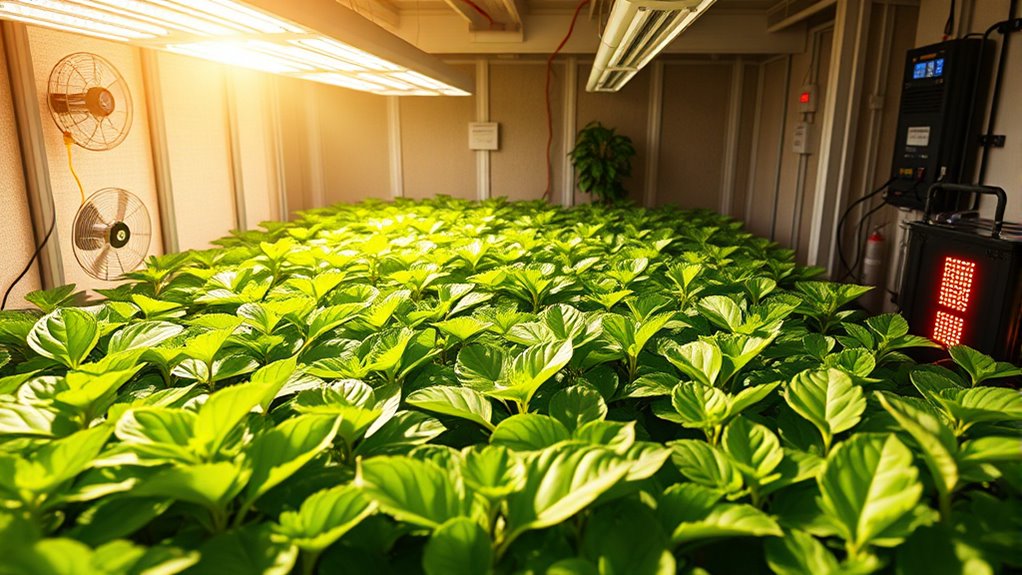
As summer temperatures soar, power outages become an increasingly common problem that can disrupt your daily routine. If you rely on a hydroponic system to grow your plants, a sudden loss of power can threaten your entire crop. Without electricity, pumps stop working, circulation halts, and plants can quickly become stressed or even die from heat and lack of oxygen. To prevent this, it’s essential to have a solid plan in place, including options like a solar backup and effective ventilation systems.
A solar backup system can be a game changer during power outages. Installing solar panels with a battery storage unit allows you to keep critical equipment running even when the grid goes down. This way, your pumps, fans, and lighting stay operational, maintaining the right environment for your plants. A solar backup offers independence from the electrical grid, reducing your reliance on utility companies and giving you peace of mind during the hottest months. It’s a sustainable, eco-friendly solution that guarantees your hydroponic system remains stable, no matter how long the outage lasts.
Ventilation systems are equally important to safeguard your plants from heat stress. During a blackout, ambient temperatures inside your grow area can skyrocket, risking damage to your crops. Installing a reliable ventilation system that can operate independently of the main power supply—perhaps with battery backup or a generator—helps regulate temperature and humidity. Proper airflow prevents heat buildup and ensures fresh oxygen reaches your plants, which is especially crucial if circulation pumps stop running. In situations where power is lost unexpectedly, having a well-designed ventilation setup keeps temperatures in check and prevents mold, root rot, or other issues caused by stagnant, overheated air. Incorporating air circulation technology can further enhance your system’s resilience during outages.
To maximize protection, combine these strategies. Use solar backup power to keep your circulation and ventilation systems running smoothly during outages, and ensure your ventilation setup is capable of functioning with minimal energy. Keep backup batteries charged and regularly test your systems to confirm they’ll operate when needed. Additionally, consider installing temperature and humidity monitors that alert you if conditions start to deviate from the ideal range. These measures enable you to respond quickly, adjusting fans or activating emergency power sources as necessary.
Frequently Asked Questions
How Can I Monitor My Hydroponic System Remotely During Outages?
To monitor your hydroponic system remotely during outages, you should set up remote sensors that track temperature, humidity, and water levels. Guarantee your system has reliable internet connectivity so you can access real-time data from anywhere. Use a secure app or platform to receive alerts if conditions change unexpectedly, helping you act quickly and prevent damage, even when you’re not physically present.
What Are the Signs of Heat Stress in Hydroponic Plants?
When it comes to heat stress in your hydroponic plants, you’re playing with fire if you ignore the signs. Look out for leaf curling, which indicates they’re trying to cool down, and root discoloration, a sign of damage beneath the surface. If you spot these, act quickly to regulate temperature and improve airflow. Catching issues early helps your plants stay healthy and thriving, even during the hottest days.
Are There Eco-Friendly Backup Power Options for Hydroponic Systems?
You can consider eco-friendly backup power options like solar generators and small wind turbines to keep your hydroponic system running smoothly during outages. Solar generators harness sunlight, providing clean, renewable energy, while wind turbines convert wind into electricity. Both options reduce your carbon footprint and guarantee your plants stay cool and well-circulated, even when the power’s out. These sustainable solutions help maintain ideal growing conditions naturally.
How Long Can Hydroponic Plants Survive Without Circulation?
Did you know hydroponic plants can survive roughly 4-6 hours without circulation? During this time, plant root health and nutrient balance are at risk, which can lead to stunted growth or disease. To keep your system thriving, monitor the duration without circulation and consider eco-friendly backup options. Maintaining circulation guarantees your plants stay healthy, and their roots stay oxygenated and nutrient-rich, even during unexpected outages.
What Are the Best Preventative Measures for Heat Damage in Summer?
To prevent heat damage in summer, you should focus on maintaining ideal temperatures for your hydroponic system. Use thermal insulation around your tanks and pipes to reduce heat transfer. Additionally, install shade cloths over your setup to block direct sunlight and keep temperatures down. Regularly monitor your system’s temperature and adjust shading or insulation as needed. These steps help safeguard your plants and ensure healthy growth during hot months.
Conclusion
As the summer sun blazes, remember you’re the shield guarding your hydroponic oasis. Power outages may threaten your plants like sudden storms, but with vigilance and backup plans, you maintain the heartbeat of your garden steady. Think of your system as a delicate symphony—your quick actions ensure it continues to dance, thrive, and flourish under the scorching sky. Stay prepared, stay resilient, and let your garden bloom against all odds.

